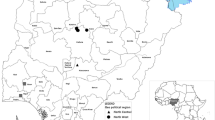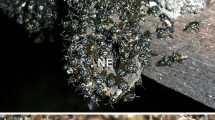Summary
-
1.
The biological significance of the tergit gland (Tergittaschendrüse) secretion of the queen honeybee was quantitatively bioassayed.
-
2.
Young worker bees are strongly attracted to the abdominal gland secretion. However, it only becomes completely effective together with the mandibular gland secretion: the mandibular gland secretion attracts at distances beyond several centimetres, whereas that of the abdominal gland only if the workers make direct contact (contact chemoreception) with the pheromone source. The abdominal gland secretion appears to stabilize the “court”.
-
3.
Chemical investigations revealed that in the abdominal gland secretion—as well as in that of the mandibular gland-several pheromones together are responsible for the attraction effect. The active pheromone complex of the abdominal gland does not contain 9-oxo-decenoic acid.
Zusammenfassung
-
1.
Die biologische Bedeutung des Sekrets der Tergittaschendrüsen der Bienenkönigin wurde mit Hilfe neu entwickelter quantitativ auswertbarer Verhaltenstests untersucht.
-
2.
Das Sekret der Taschendrüsen wirkt stark anlockend auf junge Arbeits-bienen. Es entfaltet seine volle Wirksamkeit allerdings nur gemeinsam mit dem Mandibeldrüsensekret: Das Sekret der Mandibeldrüsen wirkt anlockend über eine Distanz von mehreren Zentimetern, das Produkt der Taschendrüsen nur dann, wenn die Arbeitsbienen Fühlerkontakt mit dem Duftstoffträger aufnehmen können (Kontaktchemorezeption). Das Taschendrüsensekret scheint die “Hofstaatbildung” zu stabilisieren.
-
3.
Chemische Untersuchungen ergaben, daβ im Taschendrüsensekret ähnlich wie im Sekret der Mandibeldrüse mehrere Pheromone zusammen für die Lockwirkung verantwortlich sind. 9-Oxodecensäure ist im wirksamen Pheromonkomplex der Taschendrüsen nicht enthalten.
Similar content being viewed by others
Literatur
Butler, C.G.: The method and importance of the recognition by a colony of honeybees of the presence of its queen. Trans. R. Entomol. Soc. London 105, 11–29 (1954)
Butler, C.G.: Queen recognition by worker honeybees. Experientia 16, 424–425 (1960)
Butler, C.G., Callow, R.K., Greenway, A.R., Simpson, J.: Movement of the pheromone 9-Oxodec-2-enoic acid, applied to the body surfaces of honeybee. Entomol. Exp. Appl. 17, 112–116 (1974)
Butler, C.G., Callow, R.K., Koster, C.G., Simpson, J.: Perception of the queen by workers in a honeybee-colony. J. Apic. Res. 12, 159–166 (1973)
Butler, C.G., Paton, P.N.: Inhibition of queen rearing by queen honeybees of different ages. Proc. Roy. Entomol. Soc. London Series (A) 37, 114–116 (1962)
Butler, C.G., Simpson, J.: Pheromones of the honeybee. An olfactory pheromone from the Koschewnikow gland of the queen. Univ. Libcice Sci. Stud. 4, 33–36 (1965)
Frisch, K. von: Tanzsprache und Orientierung der Bienen. Berlin-Heidelberg-New York: Springer 1965
Gary, N.E.: Mandibular gland extirpation in living queen and worker honeybees. Ann. Entomol. Soc. Am. 54, 529–531 (1961a)
Gary, N.E.: Queen honeybee attractiveness as related to mandibular gland secretion. Science 133, 1479–1480 (1961b)
Gary, N.E.: Pheromones of the honeybee, Apis mel.. In: Control of insect behaviour by natural products (ed. Wood, D.L., Silverstein, R.M., Nakajiama, M.), pp. 29–53. New York: Academic Press 1970
Heselhaus, F.: Die Hautdrüsen der Apiden und verwandter Formen. Zool. Jb. 43, 369 (1922)
Lukoschus, F.: Zur Entiwicklung von Leydigschen Hautdrüsen bei der Honigbiene (Apis mel.). Z. Morphol. Ökol. Tiere 51, 261–270 (1962)
Morse, R.A., Gary, N.E.: Further studies of the responses of honeybee colonies to queens with extirpated mandibular glands. Ann. Entomol. Soc. Am. 56, 372–374 (1963)
Nedel, J.O.: Morphologie und Physiologie der Mandibeldrüse einiger Bienenarten. Z. Morphol. Ökol. Tiere 49, 139–183 (1960)
Pain, J.: Mesure du pouvoir inhibiteur et de l'attrictivité de l'ectohormone des reines d'abeilles. Différences individuelles. C.R. Acad. Sci. (Paris). 242, 1080–1082 (1956)
Pain, J.: Sur la phéromone des reines d'abeilles et ses effects physiologiques. Ann. Abeille 4, 73–152 (1961)
Pain, J., Hügel, M.F., Barbier, M.: Sur les, constituents de mélange attractif des glands mandibulaires des reines d'abeilles à différents stades de leur vie. C.R. Heb. Séanc. Acad. Sci. (Paris). 251, 1046–1048 (1960)
Renner, M., Baumann, M.: Über Komplexe von subepidermalen Drüsenzellen (Duftdrüsen?) der Bienenkönigin. Naturwissenschaften 51, 68–69 (1964)
Renner, M., Heinzeller, T., Wachinger, A.: Über die Saugleistung der Bienen. In Vorbereitung
Szabo, T.J., Townsend, G.F.: Behavioural studies on queen introduction in the honeybee. 1. Effect of the age of workers (from a colony with a laying queen) on their behaviour towards an introduced virgin queen. J. Apic. Res. 13, 19–25 (1974)
Velthuis, H.H.W.: Mandibular gland extirpation and the recognition of the queen. Apimondia (20th intern. Beekeeping Jubilee Congr., Bucharest), 1965
Velthuis, H.H.W.: Queen substance from the abdomen of the honeybee queen. Z. vergl. Physiol. 70, 210–222 (1970)
Velthuis, H.H.W., Es, J. van: Some functional aspects of the mandibular glands of the queen honeybee. J. Apic. Res. 3, 11–16 (1964)
Zmarlicki, C., Morse, R.A.: The effect of mandibular gland-extirpation on the longevity and attractiveness to workers of queen honeybees. Ann Antomol. Soc. Am. 57 73–74 (1964)
Author information
Authors and Affiliations
Additional information
Mit Unterstützung der Deutschen Forschungsgemeinschaft
Adressieren Sie Sonderdruckanforderungen an den Zweitautor
Rights and permissions
About this article
Cite this article
Vierling, G., Renner, M. Die Bedeutung des Sekretes der Tergittaschendrüsen für die Attraktivität der Bienenkönigin gegenüber jungen Arbeiterinnen. Behav Ecol Sociobiol 2, 185–200 (1977). https://doi.org/10.1007/BF00361901
Received:
Published:
Issue Date:
DOI: https://doi.org/10.1007/BF00361901




